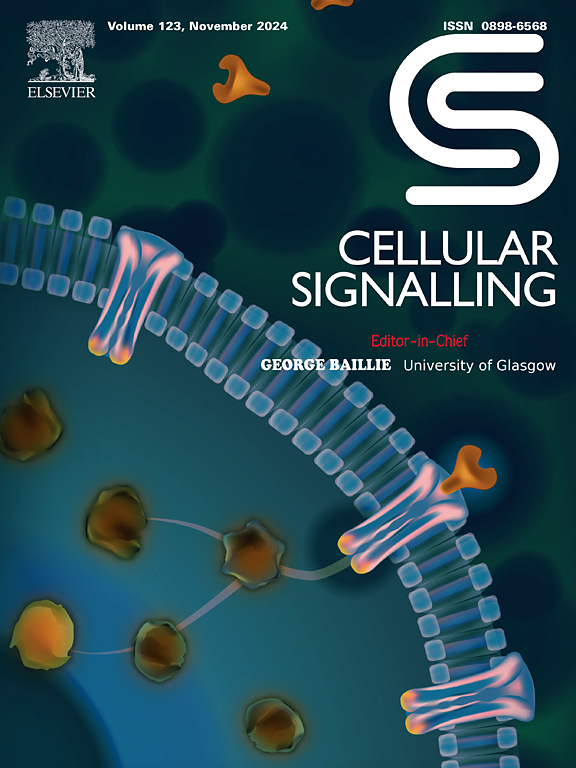Apatinib combined with paclitaxel suppresses synergistically TNBC progression through enhancing ferroptosis susceptibility regulated SLC7A11/GPX4/ACSL4 axis
IF 4.4
2区 生物学
Q2 CELL BIOLOGY
引用次数: 0
Abstract
Triple-negative breast cancer (TNBC) is highly heterogeneous, often leading to resistance to chemotherapy agents like paclitaxel (PTX) and resulting in suboptimal outcomes. The anti-angiogenic agent apatinib not only enhances chemotherapy sensitivity but also involves in regulating ferroptosis. However, the potential of combining apatinib with PTX to improve treatment efficacy in refractory TNBC by increasing tumor cell susceptibility to ferroptosis remains elusive. This study aims to elucidate whether inducing ferroptosis participates in the beneficial effects of apatinib combined with PTX to synergistically suppress TNBC. Herein, we demonstrated that the coadministration of apatinib and PTX exerted significant inhibitory effects on both primary tumor progression and distant metastases to pulmonary and hepatic tissues in TNBC-bearing murine models. Transcriptomic and proteomic analyses indicated that ferroptosis induction is a key mechanism by which the drug combination suppresses TNBC, as evidenced by a marked downregulation of SLC7A11, GPX4, NRF2, and FTH1, and a significant upregulation of ACSL4. In vitro, the combination of 5 μM apatinib and 8 nM PTX synergistically inhibited tumor cell proliferation, migration, and invasion. Notably, the combination therapy markedly augmented ferroptosis in tumor cells through the regulation of the SLC7A11/GPX4/ACSL4 axis, leading to increased intracellular iron accumulation and lipid peroxide generation, concomitant with a reduction in GSH levels. The effect of apatinib combined with PTX on enhancing ferroptosis susceptibility could be exploited as a combination treatment regimen for future TNBC therapy.
阿帕替尼联合紫杉醇通过增强铁凋亡易感调节的SLC7A11/GPX4/ACSL4轴协同抑制TNBC进展
三阴性乳腺癌(TNBC)是高度异质性的,通常导致对紫杉醇(PTX)等化疗药物的耐药性,并导致次优结果。抗血管生成药物阿帕替尼不仅增强化疗敏感性,而且参与调节铁下垂。然而,阿帕替尼联合PTX通过增加肿瘤细胞对铁下垂的易感性来提高难治性TNBC治疗疗效的潜力仍然难以捉摸。本研究旨在阐明诱导铁下垂是否参与了阿帕替尼联合PTX协同抑制TNBC的有益作用。本研究表明,在携带tnbc的小鼠模型中,阿帕替尼和PTX联合给药对原发性肿瘤进展和肺和肝组织远处转移均有显著的抑制作用。转录组学和蛋白质组学分析表明,诱导铁凋亡是该药物联合抑制TNBC的关键机制,SLC7A11、GPX4、NRF2和FTH1的显著下调以及ACSL4的显著上调证明了这一点。在体外,5 μM apatinib与8 nM PTX联合使用可协同抑制肿瘤细胞的增殖、迁移和侵袭。值得注意的是,联合治疗通过调节SLC7A11/GPX4/ACSL4轴显著增强肿瘤细胞中的铁下沉,导致细胞内铁积累和脂质过氧化生成增加,同时GSH水平降低。阿帕替尼联合PTX增强铁下垂易感性的作用可作为未来TNBC治疗的联合治疗方案。
本文章由计算机程序翻译,如有差异,请以英文原文为准。
求助全文
约1分钟内获得全文
求助全文
来源期刊

Cellular signalling
生物-细胞生物学
CiteScore
8.40
自引率
0.00%
发文量
250
审稿时长
27 days
期刊介绍:
Cellular Signalling publishes original research describing fundamental and clinical findings on the mechanisms, actions and structural components of cellular signalling systems in vitro and in vivo.
Cellular Signalling aims at full length research papers defining signalling systems ranging from microorganisms to cells, tissues and higher organisms.
 求助内容:
求助内容: 应助结果提醒方式:
应助结果提醒方式:


